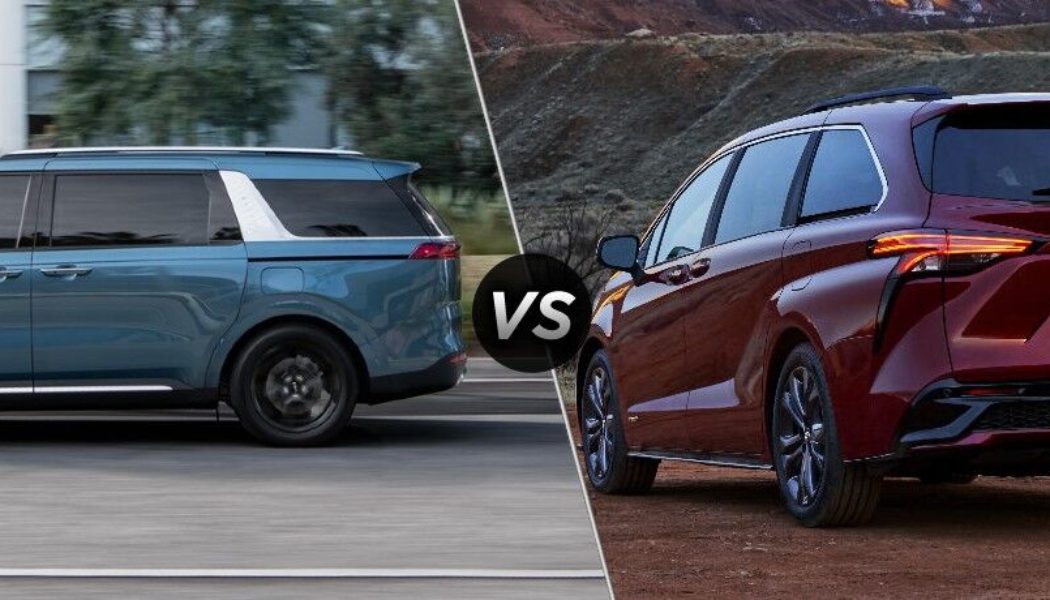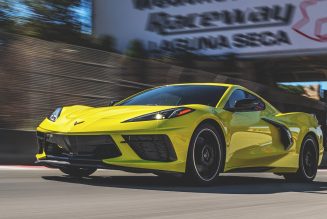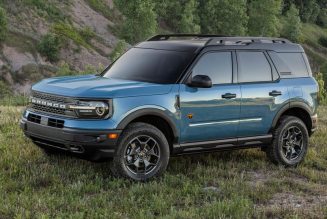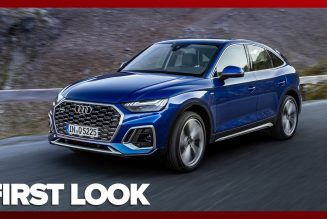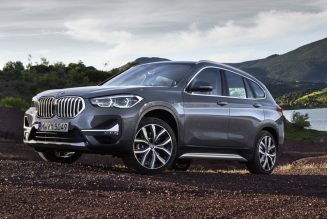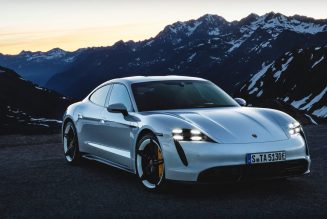In theory, doing the right thing is easy. Want to lose weight? Eat fewer calories and exercise more, right? Similarly, you might be tempted to think creating the right minivan is easy, too. All you need is a big, blobby shape, lots of seats, and a couple of sliding doors, and the job’s done, right? Turns out, no. Just like dropping pounds, it’s a lot more difficult than it seems to create a well-engineered minivan. They need to handle approximately the same with one passenger as they do with seven or eight. They need to be incredibly safe (think of the children!) yet have nearly every body panel open to create a yawning portal. Plus, it would be good if the seats could go away when an owner wants to turn the soccer taxi into a Home Depot hauler. Getting this right ain’t easy.
Don’t believe me? I can’t even count how many engineers have said how much easier it is to make a sports car than a minivan. Second, only four carmakers successfully sell minivans in the United States: Chrysler, Honda, Toyota, and Kia. Interestingly, Kia was the newest kid on the block with its slow-selling Sedona. This time, the South Korean upstart brings an even newer kid to the dance recital, the “think different”-looking Carnival. We decided to pitch it up against one of the segment’s stalwarts to see how well the top-trim Carnival XC Platinum floats against a tough schooner in the form of Toyota’s fourth-generation, hybrid-only Sienna Platinum. (I apologize for the terrible boat joke—Carnival, cruise ship, get it?—but the rest of this report is better. Probably.)
What You See
Right off the bat, the Kia jumps out to a commanding lead over the Toyota in the design department. The Carnival doesn’t look like a minivan and is indeed marketed as an MPV, or “multipurpose vehicle.” Of course, it is a minivan, but SUV-ish style is a good thing in an era where three-row SUVs—which are little more than less practical minivans—outsell every other mode of family transportation. Kia has cultivated a well-earned reputation for sharp design, and the Carnival carries on in this recent positive direction. The concave grille looks stout, helping to make Kia’s minivan look tougher than it is. From the B-pillar forward, the Carnival looks more like an SUV than a minivan. One of the many factors keeping families out of this sort of vehicle is—there’s no nice way to put this—that minivans look dorky, and therefore the people who drive them must be nerds, or lame, or worse. The Carnival offers up a different look.
The Toyota Sienna, despite its best efforts, does not. One peek from any angle, and the Sienna politely shouts, “I have several children.” It’s not cool, not even in some sort of ironic it’s-so-uncool-it’s-cool kinda way. The side is bulbous with a bizarre character line running from the front wheel to a bulging rear haunch. Normally, this sort of flourish would indicate big power moving to the rear wheels, which isn’t true. The rear is incongruous—so much aggression, so little reason why. The grille’s too big, too, but the front end is the Sienna’s best angle; there’s a bit of Alphard in it, a luxury minivan Toyota doesn’t offer in America. Even so, on looks, this is an easy win for the Kia.
It’s What’s Inside That Counts
The Sienna’s interior looks impressive—but don’t look too closely. Materials quality seems a bit cheap once you start nosing in or touching stuff. To be fair to Toyota, there’s little difference in materials quality between the Sienna and Honda’s Odyssey, and such materials are often used for their toughness more than anything. And compared to Chrysler’s Pacifica, the Toyota is made of very fine material, indeed. The problem is that the Carnival is here to disrupt the segment, and in terms of material quality in these high-trim vans, the Sienna is simply outclassed. What about in lower trim levels? We don’t know yet, as this is the first and only Carnival we’ve laid our hands on.
It’s hard to underscore this point enough, but Kia snuck a luxury interior into the Carnival. The leather is simply incredible. I would have killed for the heated/cooled, fully reclining, powered captain’s chairs (with flip-up footrests) in the middle row in high school. The Sienna also has second-row captain’s chairs and available footrests, but they’re nowhere near as plush.
The starkest difference, however, is in the infotainment screens. Toyota is way, way behind. The low-res screen displays the same old low-functionality software we’ve seen in Toyota products for more than a decade. The map, for instance, looks like it’s powered by MapQuest, back when MapQuest dominated navigation. The Carnival, on the other hand, has a top-shelf infotainment setup. The graphics are sharp and rich, the responses quick, and the screen itself appears to be designed with the interior rather than glued to it.
What about the minivan stuff? Third-row ingress and egress, seat stowage, number of USB ports, number of cupholders, that sort of thing? Nothing stark jumps out, though there are differences, including that the Kia lacks any USB-C ports. One small win for the Carnival is that those second-row thrones slide side to side. It makes installing car seats and loading or unloading a baby much easier. Third-row access isn’t class-leading in either vehicle, but it is easier in the Toyota, at least in these luxury-spec models. That’s because there is no tilt/slide mechanism. Slide them inboard if you’re skinny enough to sneak behind or slide them outboard and wriggle between the two seats.
You also cannot remove the Kia’s palatial second-row seats, which are standard and exclusive to the SX Prestige, so if you want your Carnival to haul a midway game booth, you’ll need to spec a lower trim. We did like the Toyota’s front center console, which offers lots of storage. Finally, one might question the wisdom of letting a car full of grimy children anywhere near the SX Prestige’s fine leather.
But in back, the Toyota only offers a single rear screen with no special functionality, whereas the Kia has two. More important, the Carnival comes loaded with Netflix and YouTube, meaning my 4-year-old was able to watch Octonauts—or was that Dinotrux?—while I drove him home from daycare. (He cried bloody murder the next morning when he realized he’d have to make the trip in his mom’s boring old Alfa Romeo. So much so that I wound up chauffeuring him like the sucker I am.) One more thing: The ability to adjust the front passenger seat from the driver’s seat is a huge bonus, via buttons on the inner side panel of the seat back. If you’ve ever tried to stop an angry 4-year-old from kicking the back of a seat, this is a game changer.
Another point: When you activate the Carnival’s turn signals, a high-resolution camera turns on and displays what’s in the appropriate blind spot right on the dash, taking over either the tach or the speedometer. It’s such a well-done feature—and better than Honda’s similar, right-side-only function of a few years ago. And like the Honda and Chrysler minivans (but not the Toyota), the Carnival has a camera that shows you what’s going on in the back seats, and the Kia’s offers a crisp, high-resolution feed. The Toyota inexplicably doesn’t even offer this feature, not even a low-resolution one. In summary, this Kia wins the interior battle, too.
What Moves Them?
Have I told you the Sienna is a hybrid? That’s right, Toyota has turned its warhorse minivan into a big Prius. Hope that’s what you want, because that’s the only way it’s sold. Under its hood, you will find a 2.5-liter Atkinson-cycle inline-four that makes 189 horsepower and 176 lb-ft of torque. Add in the muscle of the electric motor, and total output rises to 245 horsepower. The Kia has a 3.5-liter V-6 that pumps out 290 horsepower and 262 lb-ft. On paper, the Kia appears much stronger than the Toyota, especially considering the two weigh virtually the same—a win for the Toyota, we must say, given how much weight hybrid systems and all-wheel drive usually add. At 4,759 pounds for the Carnival and 4,781 pounds for the Sienna, the two are nearly identical in terms of performance, however.
The Kia hits 60 mph in 7.5 seconds; the Toyota does the same in 7.6 seconds. The Carnival gets through the quarter mile in 15.7 seconds at 90.7 mph, while the Sienna does the deed in 15.8 seconds at 87.8 mph. How is this possible? The Toyota’s electric motor delivers its 199 lb-ft right off the line, and its e-CVT keeps the entire driveline operating at a more optimal gear ratio. The Kia does have a fairly large braking advantage from 60 mph, at 118 versus 125 feet. However, we would like to see both be able to stop about 10 feet shorter, as braking distance translates directly to safety. Around our figure-eight course, the Kia wins with a 27.9-second lap, compared to 28.2 seconds for the Toyota. To give you some context, a Ford F-150 with the 2.7-liter EcoBoost V-6 takes 27.9 seconds.
All that said, the Toyota Sienna’s killer app is its fuel economy. The EPA rates the Carnival for 22 mpg combined, whereas the Sienna has a stellar 35-mpg combined rating. That’s right around one-third better, which is huge. The only greener minivan is the Chrysler Pacifica Hybrid, a PHEV, which offers 32 miles of electric driving and returns 82 mpg-e.
As for pricing, the Kia offers big-time value. The base price of the fancy Kia Carnival SX Prestige we reviewed here is $47,275, whereas the least expensive Sienna Platinum rings in at $51,075. The gap is even wider when you consider our as-tested stickers: The Carnival’s was $47,770, whereas the Sienna’s was $54,138. So, the Kia’s savings will pay for a good amount of gasoline.
What About Driving?
Many folks believe the least important characteristic of a minivan is how it drives. Hogwash, I say. A good, predictable driving experience raises a driver’s confidence in dealing with unexpected situations, which means a lot with kids in the back. And although it’s true that carmakers want to sell you one car, it’s even more true that they’d like to sell you several, all the while turning you into a fan or ambassador of the brand. To accomplish this, the owner of said car must at a bare minimum enjoy driving the thing. On this point, both Kia and Toyota have work to do.
The Kia Carnival does drive ever so slightly better than the Toyota Sienna. The latter’s powertrain feels unrefined, and you can feel the CVT hunting around excessively under even very light accelerator applications. The induction sound and the transmission’s fits don’t jibe with a vehicle that carries this sort of price tag. And the Sienna’s brakes are so unpredictable in terms of feel as to be unacceptable. Sure, you can excuse their badness by the fact that the Sienna employs regenerative brakes, but this isn’t 15 years ago, when such systems were relatively new and poorly calibrated across the industry. Automakers—including Toyota in some other vehicles—have made huge strides in terms of pedal feel and predictability, and there’s no excuse for these not to be much better.
The Kia rides comfortably enough, but it feels a bit too firm, and unloaded with just one passenger, it bounces around. Luckily for the Kia, the Sienna’s busy and choppy ride is worse. The Toyota does have better steering feel, as the Carnival’s tiller is overboosted. Neither offers much if any fun behind the wheel, but if the Carnival’s ride and handling were ever so slightly improved, Kia’s van would be on its way to fully transcending the segment.
In Conclusion
With the exception of fuel economy (and in this example, third-row seat access and cargo flexibility), the Carnival bests the Sienna, from looks to desirability to tech to performance to value to (barely) driving enjoyment. What’s that I hear? It’s the sound of not just Toyota’s engineers, but Chrysler’s and Honda’s, too, tearing down Carnivals to see what makes them tick. And, yes, how Kia got its new van so right.
2nd Place: 2021 Toyota Sienna
- Clever interior storage
- Big-time fuel economy
- Better steering
- Uninspiring handling and chassis
- Unrefined hybrid powertrain
- Outdated technology and infotainment
Verdict: A proper minivan with big mpg numbers, but it’s not particularly well sorted or enjoyable to use.
1st Place: 2022 Kia Carnival
- Stunning interior
- Big-time value
- Top-notch rear-seat entertainment
- VIP seats can’t be removed and have limited travel
- Ride quality on the firm side
- Not as many clever storage solutions
Verdict: The new Carnival shakes up the segment with stunning style, modern tech, and high-level execution.
| POWERTRAIN/CHASSIS | 2022 Kia Carnival SX Prestige | 2021 Toyota Sienna Platinum Hybrid AWD |
| DRIVETRAIN LAYOUT | Front-engine, FWD | Front-engine, AWD |
| ENGINE TYPE | 60-deg V-6, alum block/heads | I-4, alum block/head, plus rear permanent-magnet electric motor |
| VALVETRAIN | DOHC, 4 valves/cyl | DOHC, 4 valves/cyl |
| DISPLACEMENT | 211.8 cu in/3,470 cc | 151.8 cu in/2,478 cc |
| COMPRESSION RATIO | 12.3:1 | 14.0:1 |
| POWER (SAE NET) | 290 hp @ 6,400 rpm | 189 hp @ 6,000 rpm (gas), 180 hp (elec), 245 hp (comb) |
| TORQUE (SAE NET) | 262 lb-ft @ 5,000 rpm | 176 lb-ft @ 4,400 rpm (gas), 199 lb-ft (elec) |
| REDLINE | 6,750 rpm | Not indicated |
| WEIGHT TO POWER | 16.4 lb/hp | 19.5 lb/hp |
| TRANSMISSION | 8-speed automatic | Cont variable auto |
| AXLE/FINAL-DRIVE RATIO | 3.51:1/2.27:1 | NA |
| SUSPENSION, FRONT; REAR | Struts, coil springs, anti-roll bar; multilink, coil springs, anti-roll bar |
Struts, coil springs, anti-roll bar; multilink, coil springs, anti-roll bar |
| STEERING RATIO | 14.2:1 | 14.3:1 |
| TURNS LOCK-TO-LOCK | 3.0 | 3.0 |
| BRAKES, F; R | 12.8-in vented disc; 12.8-in disc, ABS | 12.9-in vented disc; 12.5-in vented disc, ABS |
| WHEELS | 7.5 x 19-in cast aluminum | 7.5 x 18-in cast aluminum |
| TIRES | 235/55R19 101H Continental CrossContact RX (M+S) |
235/60R18 102V Bridgestone Turanza LS100 (M+S) |
| DIMENSIONS | ||
| WHEELBASE | 121.7 in | 120.5 in |
| TRACK, F/R | 68.5/68.5 in | 67.7/68.5 in |
| LENGTH x WIDTH x HEIGHT | 203.0 x 78.5 x 68.5 in | 203.7 x 78.5 x 68.5 in |
| TURNING CIRCLE | 38.0 ft | 38.3 ft |
| CURB WEIGHT | 4,759 lb | 4,781 lb |
| WEIGHT DIST, F/R | 55/45% | 53/47% |
| TOWING CAPACITY | 3,500 lb | 3,500 lb |
| SEATING CAPACITY | 7 | 7 |
| HEADROOM, F/M/R | 39.7/37.6/36.5 in | 40.1/39.3/37.4 in |
| LEGROOM, F/M/R | 41.1/40.5/35.6 in | 40.3/39.9/38.7 in |
| SHOULDER ROOM, F/M/R | 64.2/63.2/59.5 in | 62.4/62.7/58.5 in |
| CARGO VOLUME, BEH F/M/R | —/86.9/40.2/cu ft | 101.0/75.2/33.5 cu ft |
| TEST DATA | ||
| ACCELERATION TO MPH | ||
| 0-30 | 2.7 sec | 2.4 sec |
| 0-40 | 4.0 | 3.8 |
| 0-50 | 5.5 | 5.5 |
| 0-60 | 7.5 | 7.6 |
| 0-70 | 9.7 | 10.1 |
| 0-80 | 12.1 | 13.0 |
| 0-90 | 15.4 | 16.6 |
| PASSING, 45-65 MPH | 3.9 | 4.1 |
| QUARTER MILE | 15.7 sec @ 90.7 mph | 15.8 sec @ 87.8 mph |
| BRAKING, 60-0 MPH | 118 ft | 125 ft |
| LATERAL ACCELERATION | 0.80 g (avg) | 0.82 g (avg) |
| MT FIGURE EIGHT | 27.9 sec @ 0.60 g (avg) | 28.2 sec @ 0.59 g (avg) |
| TOP-GEAR REVS @ 60 MPH | 1,600 rpm | NA rpm |
| CONSUMER INFO | ||
| BASE PRICE | $47,275 | $51,635 |
| PRICE AS TESTED | $47,770 | $54,138 |
| AIRBAGS | 6: Dual front, front side, f/m/r curtain | 10: Dual front, front side, middle side, f/m/r curtain, driver knee, passenger thigh |
| BASIC WARRANTY | 5 yrs/60,000 miles | 3 yrs/36,000 miles |
| POWERTRAIN WARRANTY | 10 yrs/100,000 miles | 5 yrs/60,000 miles* |
| ROADSIDE ASSISTANCE | 5 yrs/60,000 miles | 2 yrs/unlimited miles |
| FUEL CAPACITY | 19.0 gal | 18.0 gal + 1.9 kWh Ni-MH battery |
| EPA CITY/HWY/COMB ECON | 19/26/22 mpg | 35/36/35 mpg |
| ENERGY CONS, CITY/HWY | 177/130 kWh/100 miles | 96/94 kWh/100 miles |
| CO2 EMISSIONS, COMB | 0.90 lb/mile | 0.55 lb/mile |
| RECOMMENDED FUEL | Unleaded regular | Unleaded regular |
| *Hybrid system coverage extends to 8 yrs/100,000 miles, hybrid battery coverage to 10 yrs/150,000 miles |
